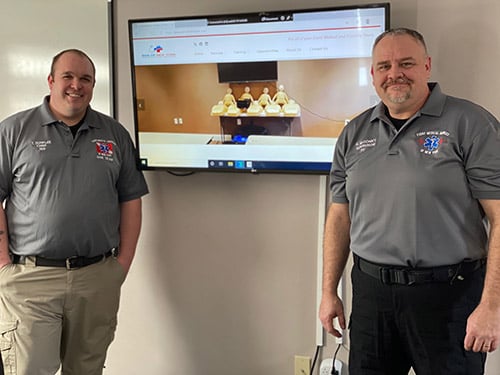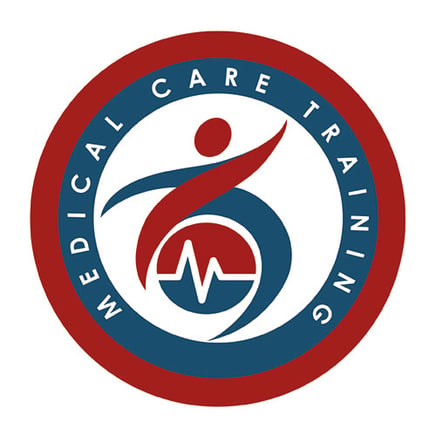 Training Center Profiles Training Center Profiles
There’s nothing more valuable than the been-there, done-that advice we can learn from our industry colleagues. In our Customer Spotlight feature, we share the ideas, lessons learned, and best practices of our Training Centers. Read on to discover how they make their TC a success.
TC Name: Event Medical Services of New York. Fort Edward, NY www.emsofnewyork.com
Personnel responding to survey: Travis Dunklee, Chief of EMS. Ryan McConky, Director of Training
How long have you been in business?
14 years, with one year as an external, for-profit ASHI TC
Based on what you know now, what advice would you have given yourself when you were starting out?
For Ryan, the lesson is patience: “It’s going to be a slow, gradual build up,” he says. “Should have done this sooner, [I’ve] enjoyed the ride,” says Travis.
Where do you go to stay current with the latest industry information and knowledge?
Various websites
What is the biggest training challenge at your company?
New clients, working within a limited budget, and travel time
Of your business or training investments that cost less than $500, what has given you the best return?
Travis reminds us of the great value of face-to-face customer contact, and Ryan cites instructor candidate training as yielding good ROI for EMS of New York.
What strategies have proved to be a waste of time and money?
Mailings
What do you do to market your training business?
Word of mouth, Facebook, ASHI, local classifieds, HubSpot
What are your plans for your Training Center for the next 5-10 years?
As a full-time brick-and-mortar business
What is the most difficult part of managing your Training Center?
Instructor scheduling and working within a limited budget
Do you have any specific training tips, such as props, scenarios, or exercises, that you would like to share?
Ketchup on the gloves is awesome for glove-removal drills.

 TC Name: Medical Care Training, Cali, Valle del Cauca, Colombia. www.medicaltraining.org TC Name: Medical Care Training, Cali, Valle del Cauca, Colombia. www.medicaltraining.org
Director: Erwin Romero
How long have you been in business?
14 years, with 4 months as an external ASHI and MEDIC First Aid TC
What is the biggest challenge for your business?
Expenses
What do you do to market your training business?
Social media and website
Based on what you know now, what advice would you have given yourself when you were starting?
Trust your potential and your way of [imparting] knowledge
What are your plans for your Training Center for the next 5-10 years?
Expanding [to have] several locations, and continuing to grow in student numbers
Of your business or training investments that cost less than $500, what has given you the best return?
Prestan manikins
What strategies have proved to be a waste of time and money?
Offering free classes
Where do you go to stay current with the latest industry information and knowledge?
ASHI Newsletter and the [latest] protocols of [relevant] agencies
Can you share a favorite Good Samaritan story about your students?
One of our training participants was able to apply his knowledge to render aid to someone who had fainted.
Do you have any specific training tips, such as props, scenarios, or exercises, that you would like to share?
I like to do simulated exercises very close to the real thing so that my students [come to an understanding of what to do] in an almost-real scenario.
TC name: Belleview Valley Nursing Home, Belleview, MO.
Director: Peggy DeClue
How long have you been an ASHI/MEDIC First Aid Training Center?
More than 10 years as an internal ASHI TC
Based on what you know now, what advice would you have given yourself when you were starting out?
Step outside your comfort zone
Does your organization offer refresher training? If so, what strategies have worked to encourage employees to participate?
Yes. [We have] mandatory training, but offer [it to employees] on their own time.
Where do you go to stay current with the latest industry information and knowledge?
Conferences and conventions
What is the biggest training challenge at your company?
Scheduling and attendance
What is the most difficult part of managing an internal Training Center?
Working within a limited budget, and getting employees to attend training
Do you have any specific training tips, such as props, scenarios, or exercises, that you would like to share?
[Our] best scenario is a tabletop exercise of a major earthquake taking place on a Saturday morning at shift change in the middle of winter with snow and ice.
We want to hear from you!
Let your colleagues know what's worked, and what hasn't, in your training business and classrooms by completing one of our 15-minute profile surveys.
If your TC provides training for individuals or organizations for a fee, click the "External TC" button. For those TCs that offer training for employees/members at no charge, choose "Internal TC."
|